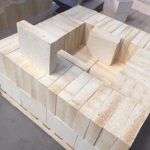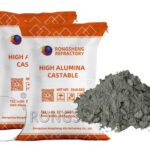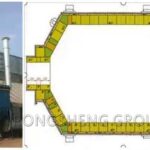In iron-making enterprises, the ball-type hot blast furnace is blast furnace blast heating equipment. The core of the technical problem of the spherical hot blast stove is the pebble bed. The pebble bed is formed by the natural accumulation of refractory balls of equal diameter. Generally, it is divided into upper and lower sections according to different ball diameters and materials. There are three main types of refractory balls used as heat medium materials in the high-temperature zone on the pebble bed, including high-alumina refractory balls, siliceous refractory balls, and magnesium-aluminum refractory balls.

High Alumina Refractory Ball
Where the mass fraction of Al2O3 is greater than 45%, the refractory material mainly composed of alumina or aluminosilicate is called high alumina refractory material.
Products due to different Al2O3 content, the mineral composition is also different. With the increase of Al2O3 content, the crystal phase of mullite and corundum in the product increases, while the glass phase decreases accordingly, and the refractory performance increases accordingly. Generally, the refractoriness of high alumina refractory ball is not lower than 1750~1790℃, and the starting temperature of softening under load is not lower than 1400~1530℃.
Al2O3 is an amphoteric oxide, so it has better resistance to acid slag corrosion, but it is weaker than siliceous refractory balls. Its corrosion resistance to alkaline slag is also better, but weaker than that of magnesium-aluminum refractory balls. When the Al2O3 content of the product is higher, its thermal stability will be significantly reduced. During the working process of the ball-type hot blast stove, the refractory ball will be affected by the periodic alternation of cold and heat at high temperatures and the erosion of alkaline gas dust or slag bonding.
The production practice shows that the high alumina refractory ball is used in the high-temperature area of the pebble bed, and its refractoriness and load softening temperature can meet the requirements, but the thermal stability and slag resistance are insufficient. Therefore, surface cracks and slag bonding often occur, resulting in poor bed permeability and shortened cleaning cycle.
Silicon Refractory Ball
Silicon refractory ball is an acidic refractory material, the mass fraction of SiO2 is more than 93%, and it has the characteristics of polycrystalline. Other components are mainly Al2O3, Fe2O3, CaO, MgO, and some alkali metal oxides.
The refractoriness of siliceous refractory ball is generally 1710~1750℃, and the softening temperature under load is relatively high, which can reach 1640~1650℃. The corrosion resistance of acid slag is strong, and the corrosion resistance of alkaline slag is very poor. The mineral phase composition of siliceous refractory balls is mainly tridymite and cristobalite. Tridymite, cristobalite, and residual quartz have large changes in volume due to the change of crystal form at low temperatures, so the thermal stability at low temperatures is poor.
Under the working conditions of the ball-type hot blast stove, the siliceous refractory ball is used in the high-temperature area on the pebble bed. Under the conditions of high temperature and large gradient temperature change, the surface of the sphere is seriously cracked, the resistance to alkaline gas dust erosion is poor, the slag bonding phenomenon is serious, and it is difficult to clean the ball.
Magnesia Aluminum Refractory Ball
The refractoriness of the magnesia refractory ball is generally over 2000℃, the softening temperature under load is generally not higher than 1550℃, and the corrosion resistance of the alkaline slag is strong. Compared with clay bricks, its thermal stability and volume stability are poor, but its thermal conductivity is very strong. Magnesium-aluminum refractory ball is a refractory product with periclase as the main mineral component and magnesia-aluminum spinel as the main binding component. In addition to the advantages of magnesia refractory products, it also has the advantages of good thermal stability and high softening temperature under load. Compared with ordinary magnesia bricks, the main features of the production process of magnesia alumina refractory balls are: The requirements for the quality of raw materials are relatively strict, and the purity of the first-grade magnesia, raw clay, and bauxite clinker used is relatively high. The particle ratio is tight, and a higher bulk density can be obtained.
At the same time, it will have a good influence on the thermal stability and sintering performance of the product, as well as reducing the porosity and increasing the softening temperature of the product under load.
The introduction of 5% to 10% Al2O3 into the ingredients is beneficial to the formation of magnesia-aluminum spinel and reduces harmful components such as forsterite and magnesium ferrite. Thus, the thermal stability of the refractory ball is improved, the thermal expansion rate is reduced, and the softening temperature under load is increased. Since the periclase and magnesia-alumina spinel in the magnesia-alumina refractory ball are both difficult-to-sinter minerals, the firing temperature is higher than that of ordinary magnesia bricks. Higher firing temperature can effectively reduce the refiring shrinkage of the product, improve the density of the product, and improve the thermal stability and high-temperature structural strength of the product.
It can be seen that the production process of magnesia-aluminum refractory balls is more precise and stricter than ordinary magnesia bricks. Its performance is also better than ordinary magnesia refractory products. If the softening temperature under load is high, it can reach about 1 620 ℃. With good thermal stability, the number of heat exchanges in 850 ℃ water can reach more than 20 times. Good slag resistance, especially the ability to resist Fe2O3 corrosion is greatly improved. The above characteristics show that the magnesium-aluminum refractory ball is suitable for the upper part of the pebble bed where the working temperature is high and frequently fluctuates.








